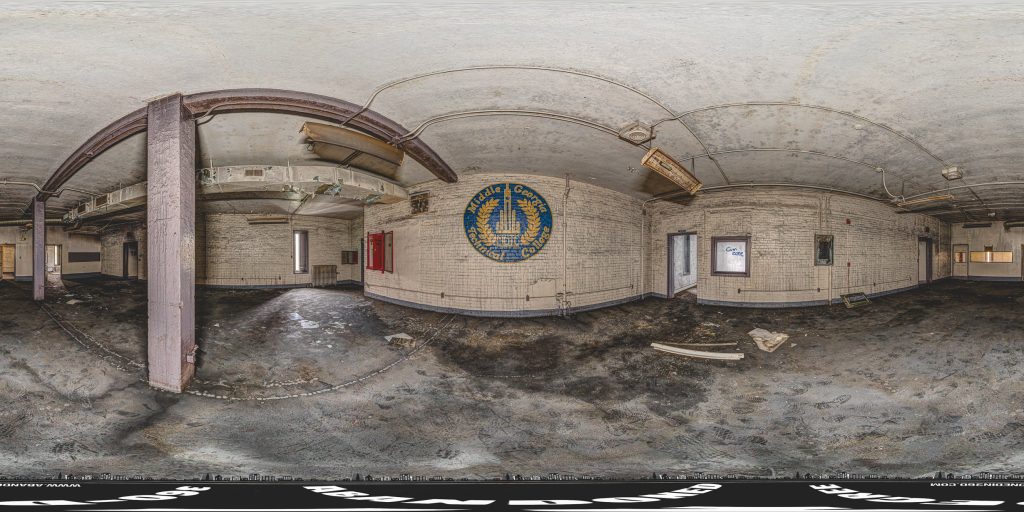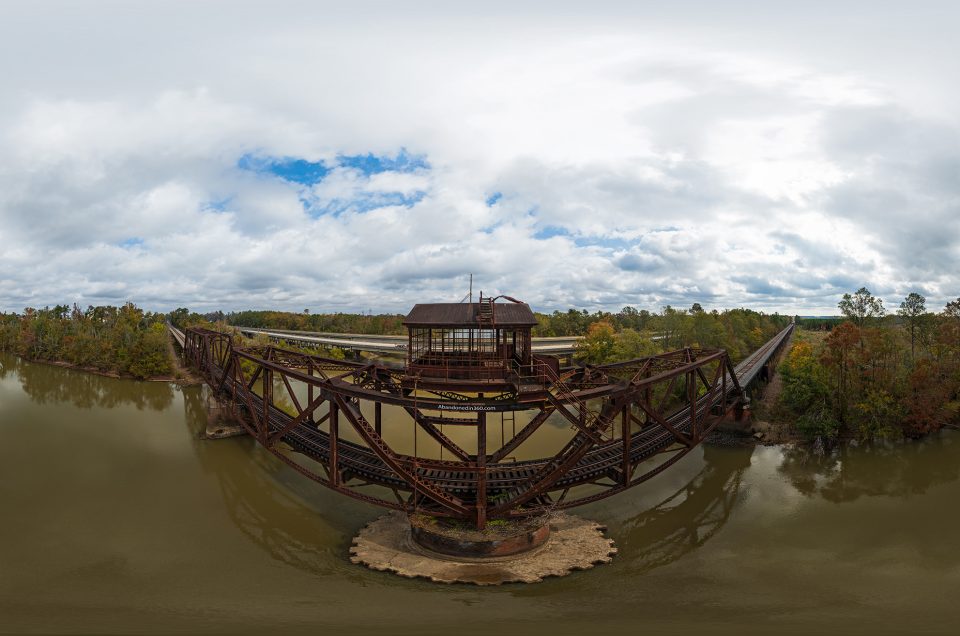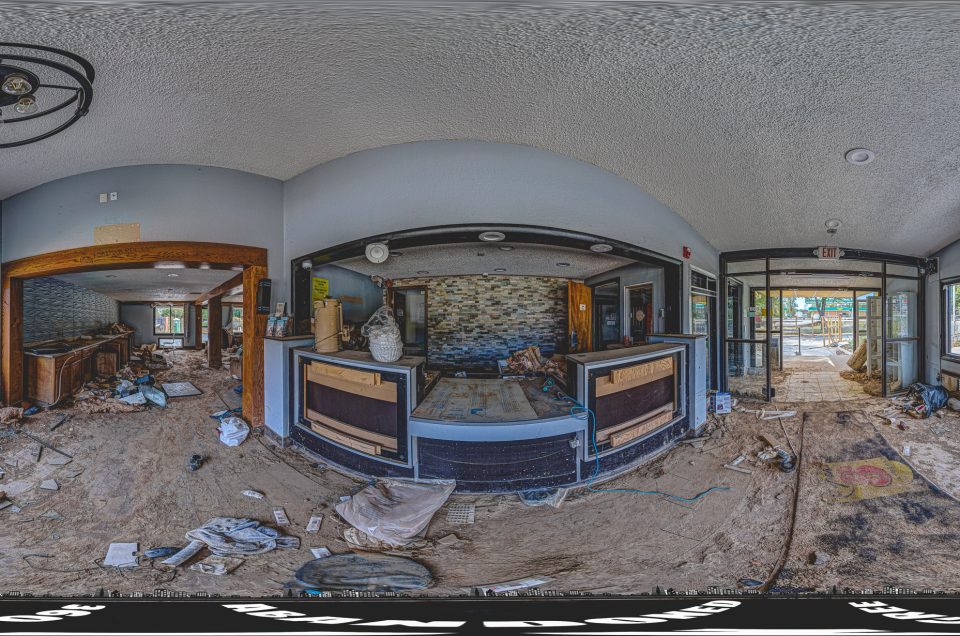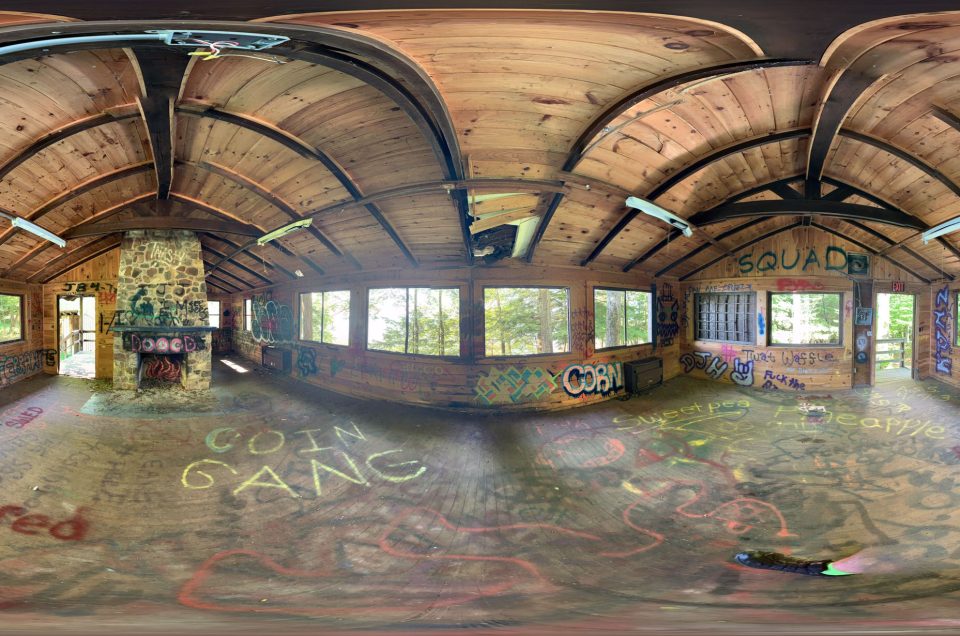The Abandoned Ingram Building at Scott State Prison: A URBEX Adventure in Georgia
Step into the history and decay of the Ingram Building at Scott State Prison, an abandoned structure in Milledgeville, Georgia that calls to anyone curious about forgotten places. Once part of a functioning prison complex, this haunting building now stands silent, offering a powerful glimpse into a past shaped by confinement, routine, and the slow passage of time. Urban explorers will appreciate the textures of peeling paint, rusting fixtures, and fading details that hint at the stories left behind.
Take a look inside the abandoned Ingram Building at Scott State Prison using the amazing 360-degree virtual tour below. This immersive experience allows you to move through the corridors and rooms at your own pace, studying every detail as if you were there in person—perfect for URBEX enthusiasts who crave exploration while respecting safety and access restrictions.
Click here to view it in fullscreen.
Why the Ingram Building hooks urban explorers
If you spend your free time hunting for forgotten corridors, peeling paint, and rusted razor wire, the Ingram Building at Scott State Prison is probably already on your radar. Tucked into the sprawling Central State Hospital campus outside Milledgeville, this hulking red-brick structure has lived several lives: segregated psychiatric ward, women’s prison unit, and, finally, part of a medium-security state penitentiary before sliding into abandonment.
Today, the Ingram Building is one of those locations that perfectly captures what it means to be abandoned in Georgia. Its story touches on mental health, mass incarceration, racial segregation, and the way the state literally converted patients into prisoners on the same piece of ground. For anyone passionate about urban exploring in Georgia and the broader world of URBEX, this building is a case study in how architecture absorbs trauma and time.
This guide takes you deep into that story—how and when the building was constructed and opened, what happened inside its wards and cellblocks, why it shut down, and how it became the haunting shell that draws explorers today. Along the way, you’ll see how the Ingram Building connects to the rise and fall of Central State Hospital, the creation of Frank Scott State Prison, and a series of scandals and controversies that still echo across the campus.
Quick note: Nothing here is an invitation to trespass. Respect fences, posted signs, and local laws. Central State’s grounds are in active use, and parts of the campus are still very much off-limits.
Central State Hospital: The enormous institution around the Ingram Building
To understand the Ingram Building, you have to zoom out to the massive system surrounding it. Central State Hospital began in 1842 as the Georgia State Lunatic Asylum and grew into one of the largest psychiatric facilities in the world. By the mid-1960s it held nearly 13,000 patients across more than 130 buildings on roughly 1,000 acres, with thousands of staff and infrastructure that functioned like its own small city.
The hospital’s annual reports from the early 1950s describe a place bursting at the seams. New buildings were rising for different patient groups—white and Black, male and female—while older structures were labeled “obsolete” and “hazardous.” Overcrowding was so intense that patients sometimes slept on mattresses in day rooms and corridors.
Daily life involved everything from electric shock treatments and insulin therapy to experimental lobotomies and malaria-based treatments for neurosyphilis. The 1950–51 report proudly lists more than 31,000 electroshock sessions in a single year, along with hundreds of surgical procedures, in an era when psychiatric practice leaned heavily on invasive physical interventions.
Within this sprawling and deeply segregated system, the building that would become the Ingram Building was part of a wave of post-World War II construction designed to house Black patients. The campus was divided racially as well as by gender and diagnosis, mirroring Jim Crow Georgia in brick and concrete.
When you stand outside the building today, the layers of that history aren’t obvious at first glance. Razor wire and guard towers scream “prison,” but the long, institutional lines and central corridors are pure asylum architecture. That clash is exactly what makes this site so compelling for urban explorers.
Birth of the Ingram Building: 1951 dedication and early use
The earliest detailed official reference to the Ingram Building appears in the 1950–51 annual report of the Milledgeville State Hospital (the name Central State used at the time). By that year, construction for new wards was underway, and the hospital’s leadership admitted they were still “markedly overcrowded” even after placing roughly 1,700 Black patients into newly built facilities.
Within that context, the report notes several key events:
-
August 1951 – patient move-in: The “colored male patients housed in the Old Colored Building were transferred to the Ingram Building in August 1951.”
-
Labor Day 1951 – official dedication: The same report describes a large barbecue for Black patients and attendants on Labor Day, noting that “on this occasion the Ingram Building was dedicated.” It states that the building was named in honor of Joe Ingram, a longtime employee who served the hospital conscientiously for over fifty-four years.
In practical terms, this means 1951 is the year the Ingram Building opened under its current name and role. Construction likely occurred just before that date as part of the hospital’s post-war building campaign, but the available records highlight 1951 as the moment when the building came online as a functioning ward and received its Ingram name.
From the beginning, the building was directly tied to racial segregation. It became a primary space for Black male patients who were moved out of older, less safe wards into what the hospital portrayed as a more modern environment.
Architecturally, the early reports also give us a sense of what the building contained:
-
New detention rooms, a physician’s office, waiting rooms, and a brick tool house were built at the Ingram Building as part of the hospital’s construction program.
-
The engineering section later mentions unloading platforms and dining facilities tied to the building, hinting at a self-contained complex with its own support spaces.
So while explorers today see steel mesh, razor wire, and prison gates, the Ingram Building began its life as a psychiatric facility housing Black men under a mental-health mandate rather than a criminal sentence.
Life in a segregated asylum ward
The 1950–51 and early-1950s reports don’t zoom in on everyday life inside the Ingram Building specifically, but they paint a vivid picture of what conditions were like for the patients it held.
Across the hospital, doctors complained of overcrowding, with hundreds of patients spread through white and Black wards. Overcrowding in psychiatric facilities is described as “calamitous,” especially for people who are delusional, severely depressed, or highly suspicious. Yet administrators still described it as preferable to using obsolete, dangerously deteriorated buildings.
Within this environment, Black male patients—now housed in the Ingram Building instead of the “Old Colored Building”—would have experienced:
-
Large ward rooms and dormitories rather than small private spaces.
-
Strict racial segregation, with separate wards, dining rooms, and gathering spaces for white and Black patients.
-
Heavy use of physical treatments, including electroconvulsive therapy, insulin shock, and sometimes lobotomy, as documented in the hospital’s medical reports.
The same report notes several deaths and serious incidents that illustrate the darker side of life in the institution:
-
A patient suicide by hanging.
-
Multiple deaths from exposure among patients allowed increased liberty.
-
A homicide in which attendants encouraged—and may have coerced—a patient in the maximum-security building to swallow a piece of cloth that caused fatal strangulation.
While these specific events weren’t tied to the Ingram Building by name, they show the climate of risk and abuse that patients faced across the campus during that era. For urban explorers drawn to psychological weight and social history, this context matters just as much as the crumbling paint and rusted doors.
The Ingram Building also stood near the hospital’s cemeteries, where thousands of patients were buried under simple numbered markers. Modern interpreters of the grounds point out that from the Memorial Cemetery, you can look through the fence toward the Ingram Building—once a hospital, later a prison—symbolizing the shift from treating mental illness to criminalizing it on the same land.
From hospital to corrections: Kemper, Ingram, and early prison use
By the late 1950s and 1960s, Georgia began to experiment with using parts of the Central State Hospital campus for incarceration as well as psychiatric care. A key source on this transition is a corrections study from the mid-1970s that traces how the state moved inmates onto the grounds.
Here’s a simplified timeline of how the hospital’s prison units evolved:
-
1958–1972 – Kemper Building as maximum-security prison: The Kemper Building on the Central State campus served as a maximum-security facility for male prisoners during this period.
-
1967 – Integration of Colony Farm inmates: When prison populations were desegregated in 1967, inmates from the Colony Farm prison camp were moved into Kemper.
-
1972 – Transfer to state corrections agency: Control of the Kemper operation shifted from the Department of Public Health (which oversaw the hospital) to the newly formed State Department of Offender Rehabilitation, formalizing the prison presence on the campus.
-
1974 – Women moved into Ingram Building: In 1974, women prisoners who had been held in the Kemper Building were moved to the Ingram Building, which by then was operating as a secure correctional facility on the hospital grounds.
That 1974 move shows how the Ingram Building’s role shifted from psychiatric ward to prison housing. Oral-history work and local public-history programs add another key detail: a library talk about Central State notes that “the Ingram building became part of Frank Scott Prison in nineteen seventy-five.”
Putting these pieces together, the building’s evolution looks like this:
-
1951–early 1970s: Ingram Building functions primarily as a hospital ward for Black male patients within a segregated mental-health system.
-
Mid-1970s: The building transitions formally into the state prison system, housing women and later other inmate populations under what would become Frank Scott State Prison.
For explorers who love following a building’s “career,” Ingram is especially fascinating because you can see both lives in the architecture: hospital-style wards and corridors re-engineered for razor-wire security and correctional control.
Frank C. Scott State Prison: a 1930s complex reclassified
The prison that eventually encompassed the Ingram Building went through several names and classifications. Official and advocacy documents refer to it as Frank C. Scott State Prison, Frank Scott Correctional Institution, and just Scott State Prison.
Several sources agree that the broader facility was constructed in 1937 as part of Central State Hospital’s expansion during the Great Depression. A prison-population analysis, for example, lists “FRANK C SCOTT CORR INSTITUTION” with a 1937 date in a table of Georgia prisons, and a Georgia corrections profile describes Scott as a 1937-era facility repurposed later as a medium-security prison.
At first, those 1930s buildings (including what would later be known as Kemper and Ingram) served strictly psychiatric roles. Only in the 1950s and 1960s did the state begin using Kemper as a maximum-security prison unit and then extend correctional use to Ingram and Holly.
By the late twentieth century, Scott State Prison was fully integrated into the Georgia Department of Corrections network. A 2008 inmate statistical profile lists Scott alongside other major state prisons, and court cases refer to it as a medium-security institution.
The prison was ultimately named for Officer Frank C. Scott, a Georgia correctional officer who died in the line of duty after a prison bus crash; surviving documentation notes that Georgia’s Frank Scott State Prison was named in his honor.
For urban explorers, this layered history means the Ingram Building is not just “an abandoned prison block.” It’s part of a Depression-era hospital complex, a segregated psychiatric ward, and a named memorial prison facility all at once.
Inside the Ingram Building during the prison years
Once fully absorbed into Scott State Prison, the Ingram Building took on a more explicitly carceral identity.
A Georgia state building inventory describes the structure as the “INGRAM ISO/SEG BUILDING,” indicating that it functioned as an isolation and segregation unit—the kind of place used for disciplinary confinement, high-security inmates, or prisoners needing separation from the general population.
Commercial real-estate listings prepared after the prison’s closure describe the Scott State Prison complex as consisting of three main buildings:
-
Kemper Building: 59,436 square feet over two floors.
-
Ingram Building: 96,360 square feet over three floors.
-
Holly Building: 147,896 square feet over three floors.
Urban-exploration photos and videos show the Ingram Building’s prison-era face clearly:
-
Chain-link and razor-wire fences encircle the approach to the building, with security gates and illuminated yard lights still in place.
-
Entryways carry signage for Scott State Prison, while the long brick façades reveal rows of windows with metal grates, a visible evolution from hospital to penitentiary.
-
Inside, explorers’ photographs show tiers of cells, heavy doors, narrow corridors, and institutional dayrooms that overlay the earlier ward layout.
During its prison years, the Ingram Building housed a mix of populations over time—women in the 1970s as documented by corrections research, and later male inmates who ended up in segregation or special housing.
For URBEX photographers, that combination of asylum bones and prison skin is part of the magic. You get:
-
Hospital-style corridors with prison bars retrofitted into the doorways.
-
Old service areas and dining rooms converted to correctional spaces.
-
Views out toward the massive Central State campus, tying the building back to its psychiatric origins.
Scandals, abuse, and heavy history
The wider Scott State Prison system, including the Ingram Building, did not operate without controversy. Several documented incidents contribute to the heavy emotional atmosphere explorers often report feeling on the property.
Sexual-assault scandal (2002)
A federal civil-rights case in the Eleventh Circuit describes a series of sexual assaults by a correctional officer, Nicholas Tuft, at Scott State Prison in the summer of 2002. An inmate identified as “John Doe” alleged that Tuft demanded sexual favors; after an altercation, internal investigations uncovered additional allegations of abuse.
The case details a pattern where staff failed to protect prisoners from assault and retaliation, painting a grim picture of the institutional culture in the early 2000s. While the opinion doesn’t name the specific building where the assaults took place, Scott’s relatively compact campus means the Ingram Building was part of the same system and culture.
Staff misconduct and decertifications
State-level records of law-enforcement decertifications list Scott State Prison employees among those disciplined or decertified for “involvement with inmates,” violations of departmental rules, and other serious misconduct.
Again, the documents don’t always identify the exact wing or unit, but they underline ongoing management problems and blurred boundaries between staff and prisoners—issues that contribute to the prison’s troubled legacy.
Asylum tragedies and neglected graves
On the hospital side of the building’s life, Central State’s own reports uncovered cases of patient deaths due to negligence and mistreatment, including the strangulation death in maximum security mentioned earlier.
Modern historians and journalists have also highlighted the cemeteries near the Ingram Building, where thousands of patients lie under metal markers, many of them never identified. Interpretive material about Central State describes looking across those grave markers toward the Ingram Building and talking about the shift “from patient to prisoner on state land” as a defining story of the twentieth century.
A specific death tied to the Ingram Building
A recent article about historical causes of death at Central State notes that one patient, admitted with a severe medical condition, died of a cerebral hemorrhage after about a week as “a patient in the Ingram Building.”
For explorers, that single detail—someone dying inside the building as a hospital patient—adds weight to the experience of walking past its boarded windows and cracked stairwells. When you explore here, you’re tracing the edges of real lives, not just anonymous ruins.
Closure and abandonment: why the Ingram Building went dark
By the 2000s, Scott State Prison (including the Ingram Building) was aging, expensive to maintain, and increasingly seen as redundant in Georgia’s prison network.
News coverage and corrections announcements describe Scott as a 72-year-old facility in 2009, aligning with the 1937 construction date. State officials framed the closure as part of a broader prison “realignment,” consolidating operations at newer or more efficient sites.
According to coverage of the decision and subsequent transfers:
-
Inmates from Scott were moved to Coastal State Prison near Savannah and possibly other facilities, allowing the state to shut down the older Milledgeville complex.
-
Local reporting calls Scott’s story “similar” to other nearby prisons on the Central State campus, with closures driven by the age of the facilities and the costs of upgrades.
By the early 2010s, the Ingram, Kemper, and Holly buildings stood vacant as part of a three-building complex occasionally offered for sale or redevelopment. Real-estate listings presented Scott State Prison as a “unique investment opportunity,” listing the Ingram Building’s size (over 96,000 square feet) and emphasizing that utilities remained available.
Copper theft and vandalism
Of course, once a large, well-known facility sits empty, it becomes a magnet for crime and scavenging. In 2019, the Georgia Bureau of Investigation arrested four men accused of stripping copper wiring and fixtures from buildings on the Central State campus—including the Ingram Building, which investigators reported had been heavily looted.
The combination of official closure, looting, and natural decay created the haunting interior explorers see in more recent photos and videos: hanging light fixtures, stripped ceilings, bare conduit, and piles of debris scattered through cellblocks and corridors.
The Ingram Building today: URBEX atmosphere and aesthetics
In recent years, the Ingram Building at Scott State Prison has quietly become a favorite target for photographers and URBEX enthusiasts who focus on sites that are both abandoned in Georgia and deeply tied to the state’s history.
Urban-exploration posts and image sets describe and show:
-
A three-story brick mass partially obscured by overgrown brush, with fencing and razor wire still circling the yard.
-
A front approach blocked by chain-link, the words “SCOTT STATE PRISON” still visible on architectural elements above the entrance.
-
Interior spaces where hospital-style dayrooms and dining halls coexist with more modern cell doors and segregation units.
-
Rusted catwalks, busted skylights, and narrow concrete outdoor spaces that make it easy to imagine the claustrophobia inmates felt here.
Photographers often mention how eerie it feels that the building stands within sight of Central State’s cemeteries, making Ingram a physical bridge between patient graves, asylum history, and mass incarceration.
Travel and history sites aimed at the general public now list Central State Hospital—and by extension, Scott and Ingram—among the most compelling abandoned places in Georgia, highlighting its scale and the haunting quality of its decaying architecture.
Legal ways to experience the campus (and why that matters)
For explorers who want to experience this story without crossing fences or ignoring “No Trespassing” signs, there are increasingly robust legal options focused on the wider Central State campus.
Tourism and heritage organizations in Milledgeville now promote:
-
Guided trolley tours that explore the grounds, including key buildings and cemeteries, led by guides with deep connections to the hospital’s history.
-
Special history events and exhibits that touch on patient life, burial practices, and the later prison era, sometimes referencing Ingram directly.
These tours don’t typically take you inside the Ingram Building itself—that space remains secured—but they offer context that makes any exterior views or photographs much more meaningful. If your style of urban exploring in Georgia leans toward historical storytelling as well as adrenaline, booking an official program can be a powerful first step.
From an ethical URBEX perspective, legal tours also respect the fact that Central State still serves vulnerable populations today. Parts of the campus remain an active behavioral-health facility, and people who live or work there deserve privacy and security.
Future plans: redevelopment dreams and uncertain outcomes
The Scott State Prison complex hasn’t been completely forgotten by planners and investors. The state and the Central State Hospital Local Redevelopment Authority (CSHLRA) have floated multiple ideas for reusing these massive structures.
A redevelopment update from several years ago, for instance, discussed plans for a Georgia International Food Center to be located at the Ingram prison site, with a new 95,000-square-foot building designed to meet the needs of a food-service company.
More recent reporting notes that the CSHLRA has brokered deals or negotiations involving former prison properties, including Scott, as part of a broader push to give abandoned hospital buildings new lives.
So far, though, the Ingram Building remains in limbo—too historically significant (and too large) to demolish easily, yet extremely expensive to adapt. That uncertainty is visible in the way the building looks: fences intact, official signage still up, but windows broken and interiors stripped.
For urban explorers, that liminal status is part of the pull. You’re looking at a structure that might still change again, even after everything it has already been.
URBEX safety and ethics at places like the Ingram Building
Because your site targets explorers, it’s worth pausing to talk about safe and responsible URBEX in the context of locations like this.
Physical safety
Buildings such as the Ingram Building at Scott State Prison come with very real risks:
-
Structural hazards: Rotting floors, missing stair treads, and failing roofs are common in mid-century institutional complexes.
-
Environmental dangers: Asbestos, lead paint, mold, and bat droppings can all be present, especially in older hospital structures.
-
Sharp and metallic hazards: Exposed rebar, broken glass, and stripped wiring left behind by copper thieves are common.
When you plan any exploration—legal or otherwise—basic precautionary gear (boots, gloves, respirator, headlamp, first-aid kit) isn’t optional; it’s foundational to staying in one piece.
Legal and ethical considerations
Locations like Ingram also raise legal and ethical questions that go beyond the usual “don’t get caught” mindset:
-
Active campus: Central State still operates as a behavioral-health facility. Parts of the grounds are off-limits not just because of property law, but because vulnerable people live there.
-
Respect for trauma: The building is tied to patient deaths, institutional abuse, and prisoner assaults. Treating it like a spooky playground without acknowledging that history is disrespectful to real people who suffered here.
For many explorers, the ideal approach at complex sites like this is a mix of:
-
Learning the history deeply (which you’re doing now).
-
Using legal tours or photography-friendly vantage points where possible.
-
Sharing images and stories in ways that foreground context rather than just shock value.
That ethic fits perfectly with the more thoughtful side of URBEX, where exploration is about engaging with forgotten stories rather than simply crossing another location off a bucket list.
Timeline recap: Key dates for the Ingram Building at Scott State Prison
To pull all of this together, here’s a streamlined timeline that you can use as a quick reference in your blog:
-
1937: Buildings that will later form part of Scott State Prison, including the Ingram site, are constructed as part of Central State Hospital’s Depression-era expansion.
-
August 1951: Black male patients from the Old Colored Building are transferred into the new Ingram Building.
-
Labor Day 1951: The Ingram Building is officially dedicated and named in honor of Joe Ingram, a hospital employee with more than 54 years of service.
-
1950s–1960s: Central State’s annual reports describe intense overcrowding, heavy reliance on physical psychiatric treatments, and ongoing racial segregation—conditions shaping life inside Ingram’s wards.
-
1958–1972: The nearby Kemper Building serves as a maximum-security prison for men; by 1972 it and related operations shift from hospital control to the Department of Offender Rehabilitation.
-
1974: Women prisoners previously housed in Kemper are moved into the Ingram Building on the Central State campus.
-
Mid-1970s: Public-history sources describe the Ingram Building becoming part of Frank Scott Prison around 1975, marking its full transition into the state prison system.
-
Late 20th century–early 2000s: Scott State Prison operates as a medium-security facility; court cases and inmate profiles place it firmly in the Georgia DOC network, with documented scandals including sexual assaults by a correctional officer in 2002.
-
2009: State officials announce the closure of Scott State Prison, citing the age of the facility and cost considerations; inmates are transferred to other prisons, including Coastal State Prison.
-
2010s: The Ingram, Kemper, and Holly buildings sit vacant; real-estate listings describe the complex, and the site begins to attract more URBEX attention.
-
2019: The GBI investigates copper theft at Central State; reports note that the Ingram Building and the Laundry Building have been heavily stripped.
-
2020s: Heritage tours, articles, and documentaries highlight Central State and the Ingram Building as symbols of Georgia’s intertwined histories of mental health care and incarceration, making the site a key destination for those fascinated by abandoned in Georgia stories and URBEX in the Southeast.
Conclusion: Why the Ingram Building belongs on every serious URBEX map
The Ingram Building at Scott State Prison is more than just another decaying brick block behind a fence. It’s a place where several major narratives collide:
-
The rise and fall of one of the world’s largest psychiatric institutions.
-
The transition from asylums to prisons on the same state-owned land.
-
The lived experiences of Black patients and prisoners in a segregated and later “reformed” system.
-
The practical reality of what happens when a 1930s complex is closed, stripped, and left to the elements.
For explorers and photographers who love urban exploring in Georgia, the building is a near-perfect subject: architecturally striking, historically dense, and emotionally heavy. It rewards slow research just as much as it rewards careful framing through a camera lens.
Whether you experience it from a legal tour stop, a careful drive around the perimeter, or curated virtual imagery, the Ingram Building deserves a place in the wider story of abandoned in Georgia locations. It is, in many ways, a textbook URBEX site—one that reminds us that every cracked hallway and rusted lock carries decades of human stories, waiting to be understood as well as photographed.
If you liked learning about this abandoned location, you might be interested in learning about the Ocmulgee River Train Swing Bridge in Georgia, the Sunken City in California, or the Micanopy Restaurant in Florida.

A 360-degree panoramic image inside the abandoned Ingram Building at Scott State Prison. Photo by the Abandoned in 360 URBEX Team
Welcome to a world of exploration and intrigue at Abandoned in 360, where adventure awaits with our exclusive membership options. Dive into the mysteries of forgotten places with our Gold Membership, offering access to GPS coordinates to thousands of abandoned locations worldwide. For those seeking a deeper immersion, our Platinum Membership goes beyond the map, providing members with exclusive photos and captivating 3D virtual walkthroughs of these remarkable sites. Discover hidden histories and untold stories as we continually expand our map with new locations each month. Embark on your journey today and uncover the secrets of the past like never before. Join us and start exploring with Abandoned in 360.
Equipment used to capture the 360-degree panoramic images:
- Canon DSLR camera
- Canon 8-15mm fisheye
- Manfrotto tripod
- Custom rotating tripod head
Do you have 360-degree panoramic images captured in an abandoned location? Send your images to Abandonedin360@gmail.com. If you choose to go out and do some urban exploring in your town, here are some safety tips before you head out on your Urbex adventure. If you want to start shooting 360-degree panoramic images, you might want to look onto one-click 360-degree action cameras.
Click on a state below and explore the top abandoned places for urban exploring in that state.








